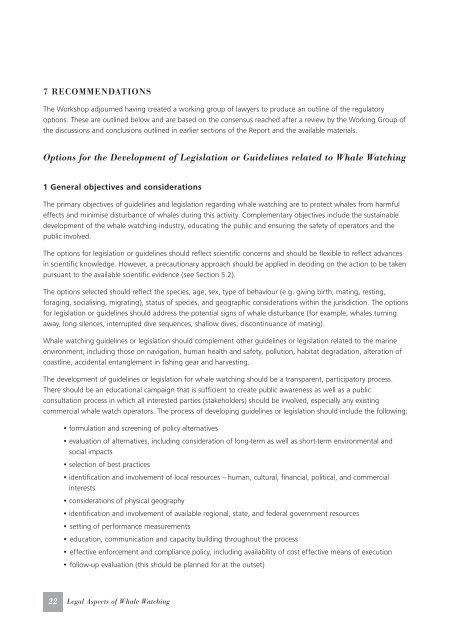leagal aspects of the whale watching.pdf - International Fund for ...
leagal aspects of the whale watching.pdf - International Fund for ...
leagal aspects of the whale watching.pdf - International Fund for ...
You also want an ePaper? Increase the reach of your titles
YUMPU automatically turns print PDFs into web optimized ePapers that Google loves.
7 RECOMMENDATIONS<br />
The Workshop adjourned having created a working group <strong>of</strong> lawyers to produce an outline <strong>of</strong> <strong>the</strong> regulatory<br />
options. These are outlined below and are based on <strong>the</strong> consensus reached after a review by <strong>the</strong> Working Group <strong>of</strong><br />
<strong>the</strong> discussions and conclusions outlined in earlier sections <strong>of</strong> <strong>the</strong> Report and <strong>the</strong> available materials.<br />
Options <strong>for</strong> <strong>the</strong> Development <strong>of</strong> Legislation or Guidelines related to Whale Watching<br />
1 General objectives and considerations<br />
The primary objectives <strong>of</strong> guidelines and legislation regarding <strong>whale</strong> <strong>watching</strong> are to protect <strong>whale</strong>s from harmful<br />
effects and minimise disturbance <strong>of</strong> <strong>whale</strong>s during this activity. Complementary objectives include <strong>the</strong> sustainable<br />
development <strong>of</strong> <strong>the</strong> <strong>whale</strong> <strong>watching</strong> industry, educating <strong>the</strong> public and ensuring <strong>the</strong> safety <strong>of</strong> operators and <strong>the</strong><br />
public involved.<br />
The options <strong>for</strong> legislation or guidelines should reflect scientific concerns and should be flexible to reflect advances<br />
in scientific knowledge. However, a precautionary approach should be applied in deciding on <strong>the</strong> action to be taken<br />
pursuant to <strong>the</strong> available scientific evidence (see Section 5.2).<br />
The options selected should reflect <strong>the</strong> species, age, sex, type <strong>of</strong> behaviour (e.g. giving birth, mating, resting,<br />
<strong>for</strong>aging, socialising, migrating), status <strong>of</strong> species, and geographic considerations within <strong>the</strong> jurisdiction. The options<br />
<strong>for</strong> legislation or guidelines should address <strong>the</strong> potential signs <strong>of</strong> <strong>whale</strong> disturbance (<strong>for</strong> example, <strong>whale</strong>s turning<br />
away, long silences, interrupted dive sequences, shallow dives, discontinuance <strong>of</strong> mating).<br />
Whale <strong>watching</strong> guidelines or legislation should complement o<strong>the</strong>r guidelines or legislation related to <strong>the</strong> marine<br />
environment, including those on navigation, human health and safety, pollution, habitat degradation, alteration <strong>of</strong><br />
coastline, accidental entanglement in fishing gear and harvesting.<br />
The development <strong>of</strong> guidelines or legislation <strong>for</strong> <strong>whale</strong> <strong>watching</strong> should be a transparent, participatory process.<br />
There should be an educational campaign that is sufficient to create public awareness as well as a public<br />
consultation process in which all interested parties (stakeholders) should be involved, especially any existing<br />
commercial <strong>whale</strong> watch operators. The process <strong>of</strong> developing guidelines or legislation should include <strong>the</strong> following:<br />
• <strong>for</strong>mulation and screening <strong>of</strong> policy alternatives<br />
• evaluation <strong>of</strong> alternatives, including consideration <strong>of</strong> long-term as well as short-term environmental and<br />
social impacts<br />
• selection <strong>of</strong> best practices<br />
• identification and involvement <strong>of</strong> local resources -- human, cultural, financial, political, and commercial<br />
interests<br />
• considerations <strong>of</strong> physical geography<br />
• identification and involvement <strong>of</strong> available regional, state, and federal government resources<br />
• setting <strong>of</strong> per<strong>for</strong>mance measurements<br />
• education, communication and capacity building throughout <strong>the</strong> process<br />
• effective en<strong>for</strong>cement and compliance policy, including availability <strong>of</strong> cost effective means <strong>of</strong> execution<br />
• follow-up evaluation (this should be planned <strong>for</strong> at <strong>the</strong> outset)<br />
22 Legal Aspects <strong>of</strong> Whale Watching
















